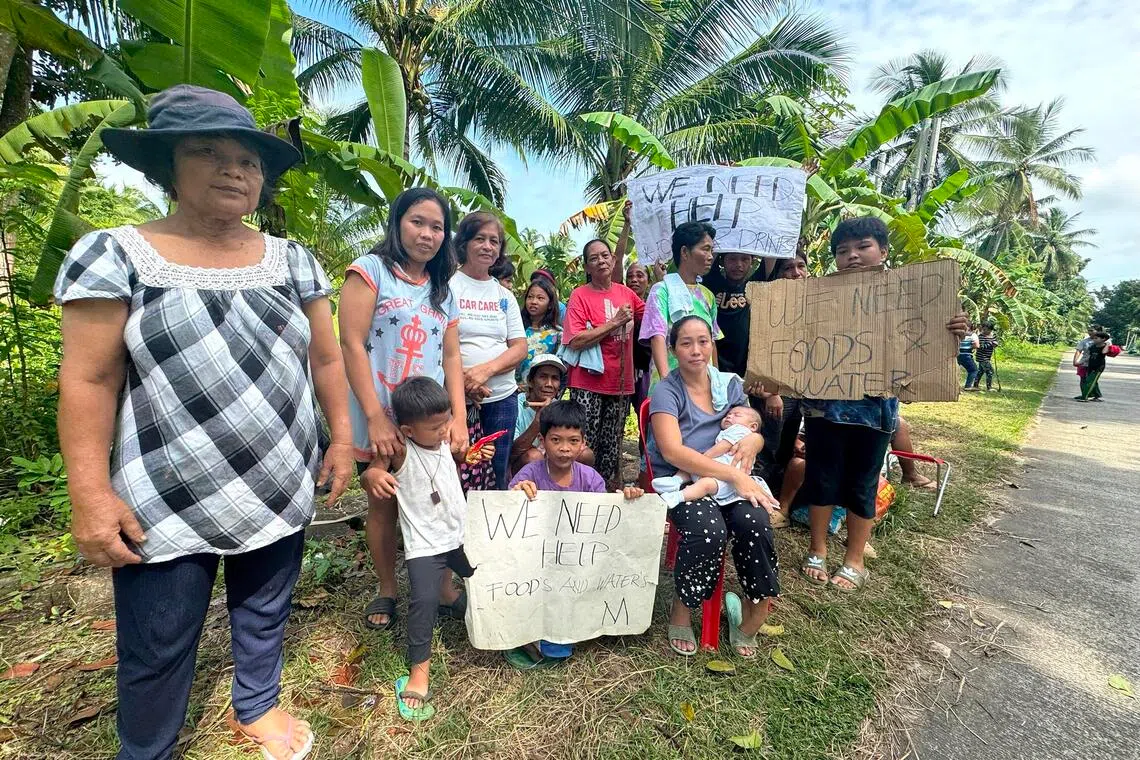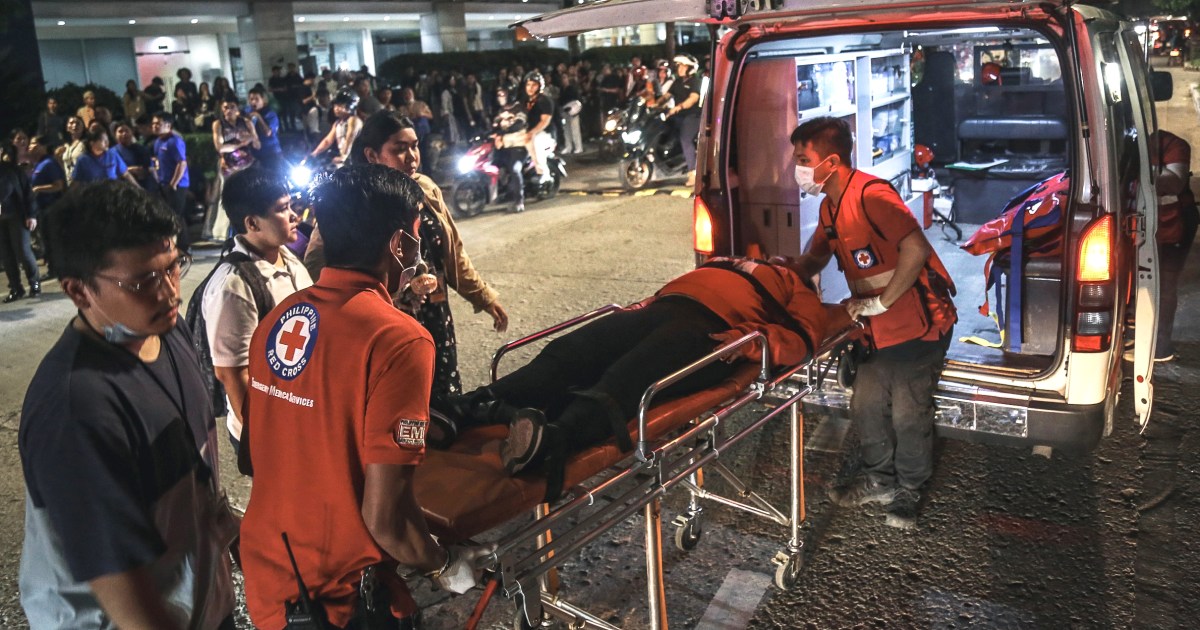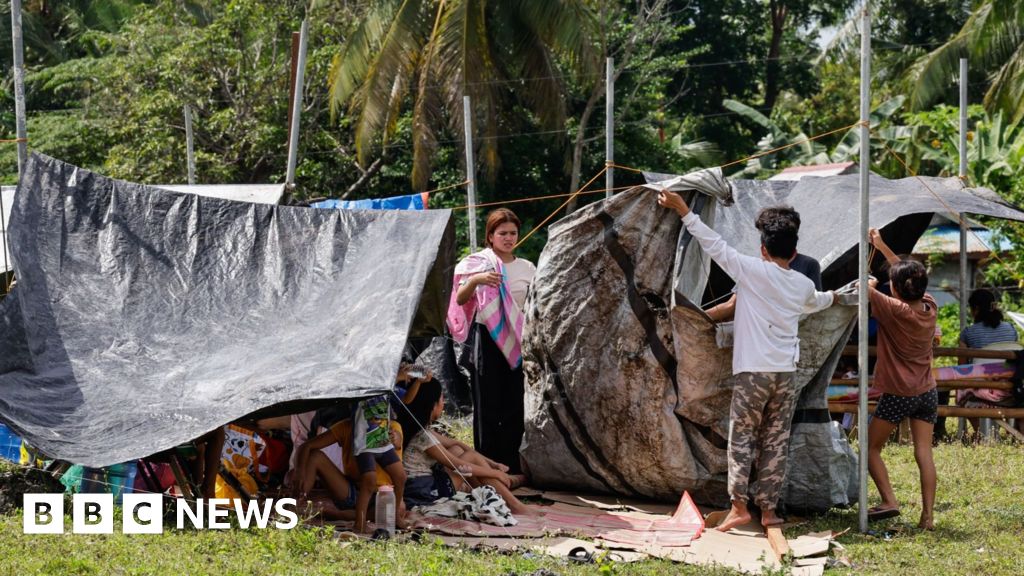Sign up now: Get ST's newsletters delivered to your inbox
Housewife Leira Macasero (second from right) with her neighbours begging for food and water next to a highway in Daanbantayan town, in Cebu, Philippines, on Sept 30, 2025.
– Under the searing midday sun, homemaker Leira Macasero, 35, stood by the roadside in a northern Cebu town, cradling her two-month-old son.
Around her, young neighbours held up cardboard signs that read: “We need food and water.”
“We’re afraid to sleep inside our homes because they might collapse,” Ms Macasero told The Straits Times. “So in the past three days, we’ve just been laying out mats on the ground to sleep at night.”
Nearly three days after a 6.9-magnitude earthquake rattled the quiet of northern Cebu in the central Philippines late on Sept 30, thousands of survivors like Ms Macasero and her family remain displaced, desperate and exposed to the elements.
With no money on hand and government aid slow to arrive in this far-flung village of Tinubdan in Daanbantayan town , Ms Macasero and her neighbours have been sleeping in open fields and begging for food on the streets, relying on the kindness of volunteers and passers-by.
Tinubdan village is around 130km from Bogo City, which has emerged as the hardest-hit area in Cebu province, where nearly half of the recorded fatalities occurred.
As at Oct 2, at least 72 people have been confirmed dead following one of the country’s deadliest natural disasters in recent years, with nearly 300 injured and more than 170,000 affected across the province.
The quake damaged power lines, bridges and several buildings, including a church that was more than 100 years old. Aftershocks continued throughout Oct 3 , as the authorities set up mobile kitchens for hundreds of evacuees and raced to provide temporary power.
With homes damaged and official evacuation centres too unsafe to enter, hundreds now stay in open fields, under tarpaulins or borrowed tents.
“We’re sleeping here on this field,” said Tinubdan Village Councilor Rutchia Rosaroso, adding that the town’s two designated evacuation centres – a basketball court and a school building – have been deemed unsafe due to the earthquake. Hundreds are now staying in tents in the open in Daanbantayan, and are scattered around the town.
In nearby San Remigio, one of the worst-hit towns, Mayor Mariano Martinez said nearly a thousand people are now staying in two tent cities – and the number is growing.
“People are not willing to go back to their houses,” he told ST. “They’re just staying outside, sometimes by the road. Many of them are coming up with signs asking for help because they feel that the government has not been that responsive.”
The mayor said around 20,000 families live in San Remigio, with 10 per cent suffering total home destruction.
Rubble surrounds a building damaged by an earthquake in San Remigio, Cebu, Philippines, on Oct 2, 2025. PHOTO: EPA
“There’s no house that has practically no damage,” he said. “Even this morning (Oct 3), there were two aftershocks.”
But with many bridges still impassable and mountainous villages still hard to reach, aid has struggled to arrive in a timely manner.
Local officials acknowledged the logistical hurdles and limited resources, even as survivors remained patient and hopeful that concerted aid will arrive soon.
“My problem here is logistics,” said Mr Martinez. “Some roads are still not passable by big trucks. Only motorcycles and small four-wheel drives can pass. That’s why we can’t bring in our relief goods”.
At present, only 50 tents have been distributed in San Remigio, with 280 more expected from the Department of Social Welfare and Development.
“This still might not be enough,” Mr Martinez admitted. “What we need are actually more tents and maybe even more portalets.”
But even if more shelters were available, many of the government’s designated evacuation centres are unusable.
The Philippines in December 2024 passed a law mandating that every city and town must have evacuation centres that are fully equipped to provide temporary but secure accommodations for disaster-stricken Filipinos.
But San Remigio’s evacuation centre was damaged by the quake, with parts of its ceiling collapsed and cracks forming on its walls. And while Daanbantayan town has a basketball court for evacuees, it cannot be used this time as part of the roof has collapsed.
Families have had to improvise and make do. Evacuee Rosalie Quiapo, 64, now stays in a borrowed tent behind the village council’s hall in Daanbantayan.
“It’s hot out here, but we’d rather stay in this tent for now because we might get trapped if another aftershock happens,” she said.
Earthquake survivor Rosalie Quiapo is temporarily living in a makeshift conditions in Daanbantayan town along with her children, in-laws, and grandchildren. ST PHOTO: MARA CEPEDA
Ms Quiapo, who fled with her daughter and two young grandchildren, drinks unboiled spring water and eats whatever is handed out by volunteers passing by in private cars.
In San Remigio’s open-field camp, 62-year-old Deborah Amor huddles with her two children and seven grandchildren under a small, self-pitched tent. Their family’s entire livelihood – a home-based business selling peanut butter, nuts and candies – was lost in the quake.
Ms Amor’s family is surviving on food packs from local officials and the occasional handout from volunteers and passers-by for now.
“If we leave this evacuation site, we won’t have any food to eat,” she said. “We’re just putting up with things here.”
Grandmother Deborah Amor watches over her grandchildren inside their tent set up at the evacuation site for earthquake survivors in San Remigio town in Cebu, Philippines on Oct 3, 2025. ST PHOTO: MARA CEPEDA
Even basic hygiene remains a challenge, as running water has yet to be reconnected to homes. There are no proper shower facilities at the evacuation site, and insufficient portalets. In San Remigio, there are about 10 portable toilets to be shared among the 1,000-odd people living in tents.
According to Councilor Rosaroso, Tinubdan village has yet to receive tents. Only 120 food packs has arrived so far, a fraction of the 593 households in need.
“It’s really not enough, so we’re hoping government aid will come soon,” the councilor said.
Mayor Martinez said the municipal hall itself is unsafe for use and has yet to be given the all-clear by government engineers. He also acknowledged gaps in aid coordination among local officials.
“Sometimes the government takes a little while (to react),” he said. “What we need from the provincial government is logistics. We’ve got to clear this up first before our packs from the Municipal Social Welfare Department come.”
Despite the delays, survivors say they are not angry. They understand that the earthquake has damaged roads and that aid takes time to arrive. Still, they remain hopeful that help will soon reach them.
“We understand the delays,” Ms Macasero said. “But we’re hoping help will finally reach us.”
The Cebu quake was the country’s deadliest since at least 2013, when a 7.2-magnitude quake struck the neighbouring island of Bohol, killing 222 people.
The Philippines sits on the Pacific “Ring of Fire” and experiences more than 800 quakes each year.
[SRC] https://www.straitstimes.com/asia/se-asia/cebu-quake-survivors-beg-for-food-sleep-in-open-fields-as-government-aid-stalls
 Visit the website
Visit the website







